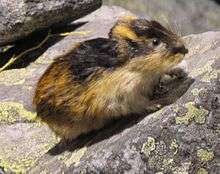True lemming
The genus Lemmus contains several species of lemming sometimes referred to as the true lemmings. They are distributed throughout the Holarctic, particularly in the Palearctic.
| True lemmings Temporal range: Pleistocene - Recent | |
|---|---|
 | |
| Norway lemming (Lemmus lemmus) | |
| Scientific classification | |
| Kingdom: | Animalia |
| Phylum: | Chordata |
| Class: | Mammalia |
| Order: | Rodentia |
| Family: | Cricetidae |
| Subfamily: | Arvicolinae |
| Genus: | Lemmus Link, 1795 |
| Species | |
|
L. amurensis | |
Description
Head and body is 10-13.5 cm, and tail length is 18–26 mm. Weight ranges from 40-112 g. They are grey or brown. Unlike the collared lemmings, their coats do not change color in winter. They stay brown and grey.
Natural history
These lemmings are found predominantly in tundra or high elevations. Populations can fluctuate widely and mass migrations do take place. This mass migration is probably the source of the myth that lemmings commit mass suicide. These intense population booms appear to be most common in the northern part of its range (such as Lapland).
Gestation is 16–23 days. Litters are 1-13 (7 average). Young are sexually mature after 14 days. When conditions are favorable, these demographic parameters allow for a veritable explosion in population size.
Species
- Amur lemming - (Lemmus amurensis)
- Norway lemming - (Lemmus lemmus)
- Wrangel Island lemming - (Lemmus portenkoi)
- Siberian brown lemming - (Lemmus sibiricus)
- North American brown lemming - (Lemmus trimucronatus)
References
- Duff, A. and A. Lawson. 2004. Mammals of the World A Checklist. New Haven, Yale University Press.
- Musser, G. G. and M. D. Carleton. 2005. Superfamily Muroidea. pp. 894–1531 in Mammal Species of the World a Taxonomic and Geographic Reference. D. E. Wilson and D. M. Reeder eds. Johns Hopkins University Press, Baltimore.
- Nowak, R. M. 1999. Walker's Mammals of the World, Vol. 2. Johns Hopkins University Press, London.